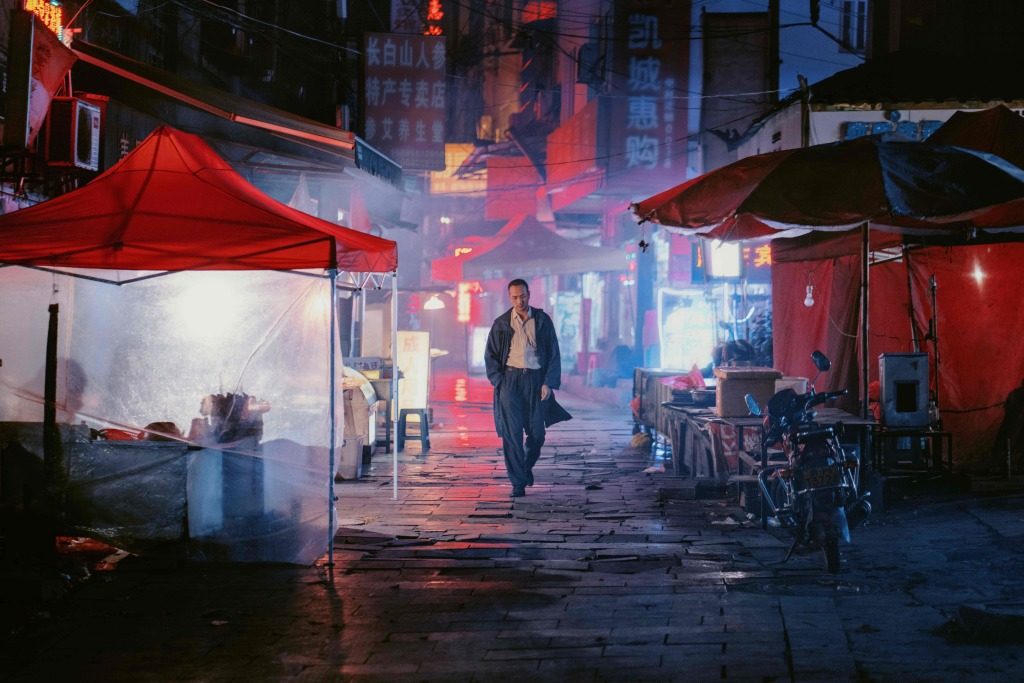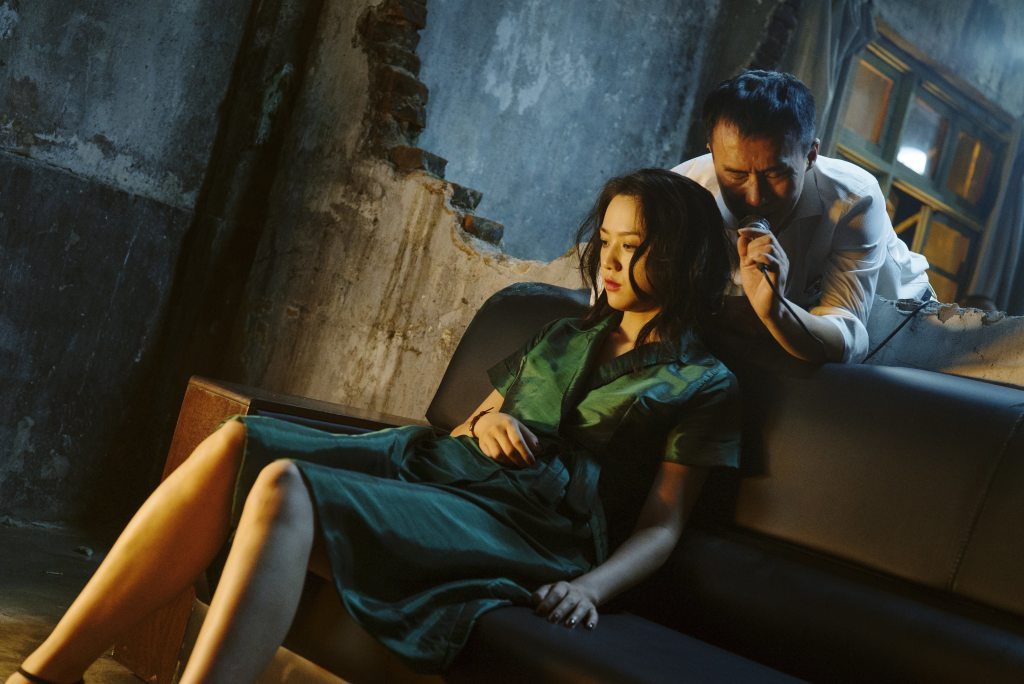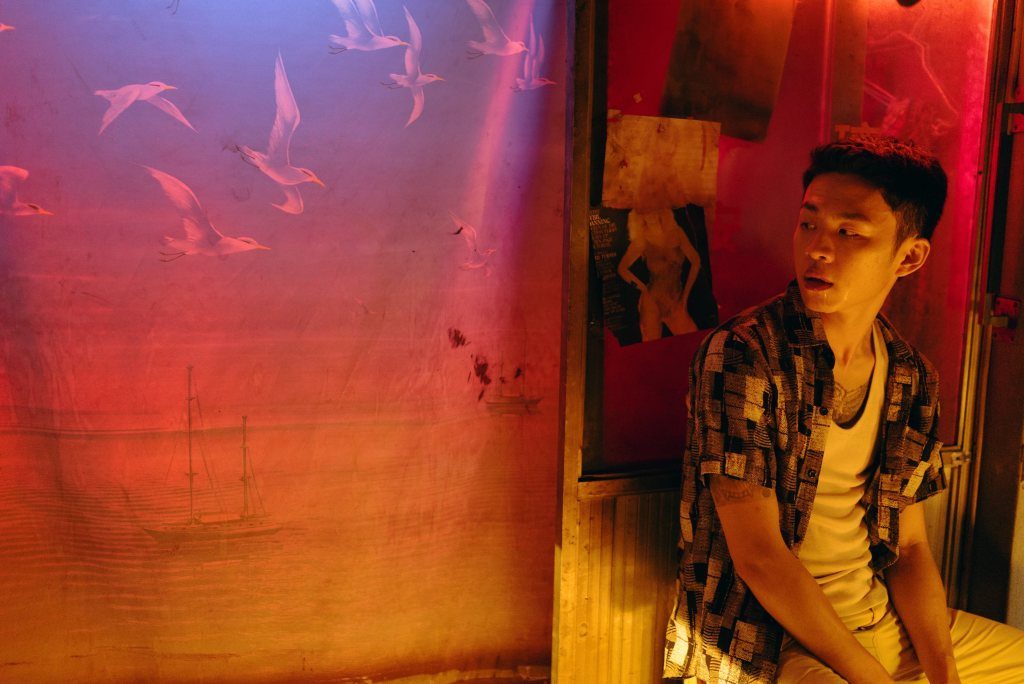
Jue Huang in a scene from Long Day’s Journey Into Night. Photo by Bai Linghai, courtesy Kino Lorber.
In the singular Chinese neo-noir Long Day’s Journey Into Night, Luo (Jue Huang) embarks on a search to find the mysterious woman he dallied with twenty years before. As he follows the clues, he plunges into an atmospheric underworld of dripping darkness and people who don’t want to talk. Along the way, he encounters the sultry, down-on-her-luck floozy Wan Qiwen (Wei Tang), whose lethal, fedora-adorned boyfriend does not want to relinquish her to Luo’s quest.
After a low burn beginning, Luo’s search reaches its climax in a spectacular ONE-HOUR single shot. It’s nighttime and both the exteriors and interiors are lit to evoke a surreal world stained by noirish danger. The shot requires the camera to follow Luo and Wan Qiwen, together and separately, inside and outside, between various levels and twice past a nervous horse, all while other characters interact with them. It’s right up there with the magnificent shots in Children of Men, Goodfellas, Touch of Evil, The Secret in Their Eyes, Atonement, Gun Crazy and the one-shot film Victoria.
Long Day’s Journey Into Night is the triumph of writer-director Bi Gan, who never forgets that he is telling his story in the medium of cinema. Long Day’s Journey Into Night is so atmospheric that sometime we feel the dankness of his set designs. Repeatedly, the richest of colors stand out against noirish backdrops. Wan Qiwen is unforgettable in her satiny emerald green dress, lit by Luo’s headlights as he tracks her by automobile in a dark tunnel. (Bi Gan has acknowledged his admiration for Wong Kar-wai, and Bi Gan has created a film as visually intoxicating as Wong Kar-wai’s.) Ban Gi used three directors of photography; the second cinematographer prepared the final shot for the third. There are recurring themes of spinning rooms, flooded floors and dripping ceilings, single flames and sparklers. The soundtrack centers on ambient sound, with very few musical cues.

Wei Tang, Yongzhong Chen in a scene from Long Day’s Journey Into Night. Photo by Liu Hongyu, courtesy Kino Lorber.
All of this enhances the story of Luo’s obsession with a doomed romance (and possibly more than one doomed romance). He can’t sure that what he hears is true – or even that what he sees is real. It’s a world filled with dissolute and murderous men and unreliable women. Luo asks a man, “Is that child yours?” and is answered, “She was a master story teller” (not a complement in this instance).
Bi Gan says, “It’s a film about memory”. Indeed, he has Luo say, “The difference between film and memories is that film is always false. They are composed of a series of scenes. But memories mix truth and lies. They appear and vanish before our eyes .”
That final shot is in 3D. Bi Gan says, “After the first part (in 2D), I wanted the film to take on a different texture. But I believe this three-dimensional feeling recalls that of our recollections of the past. Much more than 2D, anyway. 3D images are fake but they resemble our memories much more closely.”

Hong-Chi Lee in a scene from Long Day’s Journey Into Night. Photo by Liu Hongyu, courtesy Kino Lorber.
This film is entirely written by Bi Gan, with no apparent relationship to the identically-titled 1962 film of the Eugene O’Neill play, the famed four-hander with Katharine Hepburn, Ralph Richardson, Jason Robards and Dean Stockwell. The Mandarin title of Bi Gan’s film is literally Last Evenings On Earth, a title which came from a short story by Roberto Bolaño. Bi Gan just liked the title Long Day’s Journey into Night and thought that it fit the spirit of his film.
Long Day’s Journey Into Night is the biggest Chinese art house hit ever, and won an award at Cannes in 2018. It opens this weekend in the Bay Area.
